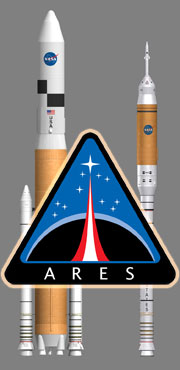
Even as NASA tries to get STS-121 off the launch pad at KSC, NASA has announced the new system that will replace the Shuttle Transportation System (STS), named Ares. The Crew Launch Vehicle, being developed on the basis of the Shuttle SRB to launch the next NASA human-carrying spaceship, will be called the Ares I. The planned heavy-lift follow on will be called the Ares V.
It's appropriate that we named these vehicles Ares, which is a pseudonym for Mars," said Scott Horowitz, associate administrator for NASA's Exploration Systems Mission Directorate, Washington. "We honor the past with the number designations and salute the future with a name that resonates with NASA's exploration mission."
The "I and V" designations pay homage to the Apollo program's Saturn I and Saturn V rockets, the first large U.S. space vehicles conceived and developed specifically for human spaceflight.
The crew exploration vehicle, which will succeed the space shuttle as NASA's spacecraft for human space exploration, will be named later. This vehicle will be carried into space by Ares I, which uses a single five-segment solid rocket booster, a derivative of the space shuttle's solid rocket booster, for the first stage. A liquid oxygen/liquid hydrogen J-2X engine derived from the J-2 engine used on Apollo's second stage will power the crew exploration vehicle's second stage. The Ares I can lift more than 55,000 pounds to low Earth orbit.
Ares V, a heavy lift launch vehicle, will use five RS-68 liquid oxygen/liquid hydrogen engines mounted below a larger version of the space shuttle's external tank, and two five-segment solid propellant rocket boosters for the first stage. The upper stage will use the same J-2X engine as the Ares I. The Ares V can lift more than 286,000 pounds to low Earth orbit and stands approximately 360 feet tall. This versatile system will be used to carry cargo and the components into orbit needed to go to the moon and later to Mars.
Picture courtesy of NASA.